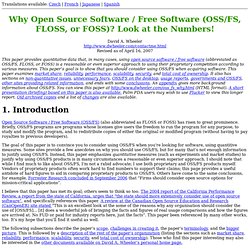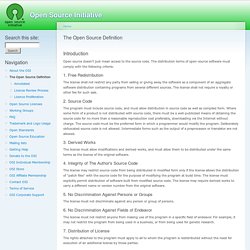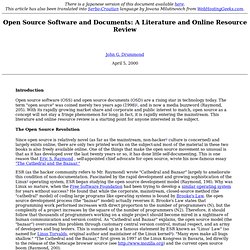

Assignment2_IS679_Individual. Assignment2_Part1. ASSIGNMENT 2 PART 1(Individual) Yingchang Yuan (1) Ossi-literature-review. Why Open Source Software / Free Software (OSS/FS, FOSS, or FLOSS)? Look at the Numbers! Translations available: Czech | French | Japanese | Spanish David A.

Wheeler Revised as of April 16, 2007 This paper provides quantitative data that, in many cases, using open source software / free software (abbreviated as OSS/FS, FLOSS, or FOSS) is a reasonable or even superior approach to using their proprietary competition according to various measures. This paper’s goal is to show that you should consider using OSS/FS when acquiring software.
Open Source Software / Free Software (OSS/FS) (also abbreviated as FLOSS or FOSS) has risen to great prominence. The goal of this paper is to convince you to consider using OSS/FS when you’re looking for software, using quantitive measures. I believe that this paper has met its goal; others seem to think so too. The following subsections describe the paper’s scope, challenges in creating it, the paper’s terminology, and the bigger picture. 1.1 Scope 1.2 Challenges Another problem is that many users of OSS/FS are reluctant to admit it. Ical-43_144_317_1_RV. The GNOME Project. The GNOME Project is a community behind the GNOME desktop environment and the software platform it is based on.

It consists of all the software developers, artists and active users of GNOME. GNOME Translation Project[edit] GNOME Foundation[edit] In August 2000, the GNOME Foundation was set up to deal with administrative tasks and press interest, and to act as a contact point for companies interested in developing GNOME software. While not directly involved in technical decisions, the Foundation does coordinate releases and decide which projects will be part of GNOME.
Programs and events[edit] The GNOME Project holds several community programs and events, usually tailored to local users and developers. Among the project's community programs is the Outreach Program for Women, established with the goals of increasing women participation and improving the resources available to all newcomers for getting involved in GNOME.[7] Collaboration with other projects[edit] References[edit] The Open Source Definition. Open source doesn't just mean access to the source code.

The distribution terms of open-source software must comply with the following criteria: 1. Free Redistribution The license shall not restrict any party from selling or giving away the software as a component of an aggregate software distribution containing programs from several different sources. The license shall not require a royalty or other fee for such sale. 2. What is open source, and what is the Open Source Initiative. Open source is a term describing a means of developing and distributing software that ensures software is available for use, modification, and redistribution by anyone.

Generally, anyone can download open source software for little or no cost, and can use, share, borrow, or change it without restriction. Open source practice promotes software reliability and quality by supporting independent peer review and rapid evolution of source code. The Open Source Initiative (OSI) is a non-profit corporation whose goal is to promote the use of open source software in the commercial world. To accomplish this goal, OSI maintains and promotes the Open Source Definition and offers the OSI Certified Open Source Software Certification Mark and Program. To be OSI certified, the software must be distributed under a license that guarantees the right to read, redistribute, modify, and use the software freely. Case 2 - Individual Assignemet. Open Source Software and Documents: A Literature and Online Resource Review. Introduction Open source software (OSS) and open source documents (OSD) are a rising star in technology today.

The term "open source" was coined merely two years ago (1998)1, and is now a media buzzword (Raymond, 205). With its rapidly growing market share and corporate and public interest to match, open source as a concept will not stay a fringe phenomenon for long; in fact, it is rapidly entering the mainstream. This literature and online resource review is a starting point for anyone interested in the subject.
The Open Source Revolution Since open source is relatively novel (as far as the mainstream, non-hacker2 culture is concerned) and largely exists online, there are only two printed works on the subject-and most of the material in these two books is also freely available online. ESR (as the hacker community refers to Mr. History So how did all this come about? Is Open Source Right For Your Organization. This article originally ran in the November 1 edition of The NonProfit Times.

Lots of people seem to be talking about “open source” software these days, but for non-techies, it’s not always easy to find out more about this option. The term “open source” itself means that the actual source code written by programmers can be viewed, modified or downloaded by anyone, and the software is typically developed, marketed and distributed by a loosely organized community of individuals rather than a vendor. It’s often distributed for free. This makes it appealing to organizations seeking to meet their goals on limited budgets, but “open source” can mean different things to different people—and so can “free.” Is it a good idea for nonprofits to take it on, or can it cause more problems than it might solve?